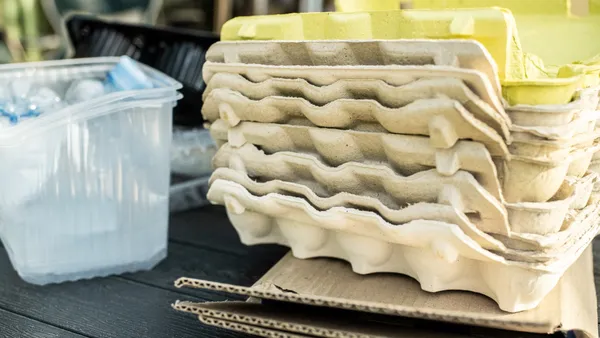Dive Brief:
- The U.S. Plastics Pact on Monday released an updated strategic plan to help participating companies and organizations, or “activators,” change how they design, use and reuse plastics in their packaging. The plan aims to continue work on existing 2025 targets that are unlikely to be met.
- Dubbed Roadmap 2.0, this version still uses 2020 as the baseline year and sets goals for 2030 that include reducing virgin plastic use by 30%, recycling 50% of plastic packaging and achieving an average of 30% postconsumer recycled or responsibly sourced biobased content in plastic packaging.
- These new targets are the same as, or very similar to, the goals laid out in the original strategy, Roadmap to 2025, with the deadline moved from 2025 to 2030 and a couple additions. Work toward the Roadmap 2.0 targets will begin Jan. 1, 2026.
Dive Insight:
USPP, part of the Ellen MacArthur Foundation's Plastics Pact Network, exists to create a “circular economy for plastics” in the United States. Many companies have aligned their own sustainable packaging goals to these targets and achieved varying degrees of progress. The new road map document emphasizes the importance of cross-sector collaboration and innovation to achieve the goals.
It notes that the original road map, which was published in 2021 and used the baseline year of 2020, was a necessary catalyst for immediate engagement on keeping plastic packaging out of the environment, absent federal regulations. Originally, 62 activators joined the efforts; the count has since swelled to more than 130. The list of activators currently includes the likes of Amcor, the American Beverage Association, Nestlé, the US Composting Council and Walmart.
The four original 2025 targets were:
- Define a list of packaging that is problematic or unnecessary (by 2021) and take measures to eliminate them (by 2025).
- 100% of plastic packaging will be reusable, recyclable or compostable.
- Undertake ambitious actions to effectively recycle or compost 50% of plastic packaging.
- Average of 30% recycled content or responsibly sourced, biobased content.
USPP published its 2022 annual report earlier this year, in which it updated progress toward these 2025 goals. Emily Tipaldo, executive director of USPP, said at the time that the group’s work was the first time “companies had ever reported plastic packaging data in this way and to this level of detail in the United States. It’s very much been a learning curve over the last three years.”
By the end of 2022, activators’ progress included: developing a list of 11 problematic plastics and decreasing those materials’ use from 14% to 8%; for target 2, increasing the amount of reusable, recyclable or compostable plastic packaging placed on the market from 37% to 47.7%; and increasing the use of PCR or responsibly sourced biobased content in plastic packaging from 7% to 9.4%.
Tipaldo said activators have learned a lot and their strategies have evolved since USPP’s formation in 2020. For instance, extended producer responsibility laws did not exist in the U.S. then, but now five states have enacted such legislation. Maine, Oregon, Colorado and California did so across 2021 and 2022, and just last month Minnesota passed EPR legislation. Tipaldo said policy is necessary to complement USPP’s work and drive the demand for PCR.
Roadmap 2.0 picks up where the original version ends, according to the report, and aims to advance some new ideas while continuing some from the previous document. For instance, it puts a greater focus on reuse innovations and implementation while specifying a virgin plastic reduction target.
The five 2030 targets are:
- Eliminate all items on the Problematic and Unnecessary Materials List and reduce the use of virgin plastic by 30%.
- Design and manufacture 100% of plastic packaging to be reusable, recyclable or compostable.
- Effectively recycle 50% of plastic packaging and establish the necessary framework to recycle or compost packaging at scale.
- Achieve an average of 30% postconsumer recycled content or responsibly sourced biobased content across all plastic packaging.
- Identify viable reusable packaging systems and increase their implementation and scale, as part of reducing the use of virgin plastics.
“Roadmap 2.0 is not just a continuation; it's an evolution. Our initial targets were intentionally ambitious to spark rapid change,” Tipaldo said in a newly released statement. “With Roadmap 2.0, we're taking what we have learned and succeeded to the next level, focusing on innovative solutions and addressing broader impacts. We are committed to working collaboratively with our activators and stakeholders to make these targets a reality.”
In February, Tipaldo said that USPP would continue driving toward plastic circularity progress even if activators weren’t able to meet some of the 2025 targets, and the group would retool as needed along the way. USPP is focused on the “transparency and it being meaningful. I would just want people to remain optimistic,” even if the progress isn’t as fast as some people had hoped, she said.
USPP said in a news release that publishing the new strategy 18 months prior to when it takes effect will allow plenty of time for activators to prepare for the new objectives and challenges.













